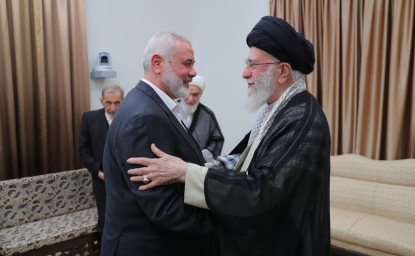On April 5, the Senate Homeland Security Committee held a hearing on the causes of rising ISIS attacks in Europe and the implications for U.S. policy. The following are excerpts from committee members and witness testimony during the hearing.
Chairman Ron Johnson (R-WI)
“The purpose of this hearing is to understand the terrorist threat in Europe and what it means for our security. On March 22, 2016, ISIS-linked terrorists bombed the airport entry hall and train station in Brussels -- killing 32, including four Americans.”
“Today, we will ask three questions. First, what are the root causes of the terrorism threats in Europe? Second, how is the threat from ISIS and other terrorist organizations changing? Third, what do the challenges in Europe and the changing terrorism threat mean for our security? And what actions must we now take to protect the American people?”
Senator Thomas Carper (D-DE)
“As with the Paris terror attacks, similar attacks in places around the world like Pakistan and Turkey, as well as the Boston Marathon and San Bernardino attacks on our shores, what happened in Brussels exposes once again the vulnerability of public places such as malls, train stations, and airports.”
“We must continuously sharpen our ability to predict and prevent terrorist plots through the use of our robust intelligence and law enforcement capabilities. Refining these tools and ensuring that we keep pace with the evolving threats we face is an important responsibility of our federal agencies and Congress.”
“We also have a responsibility, along with our international partners, to continue to take the fight to ISIS in Iraq, Syria and elsewhere. ISIS’s recent losses have been severe. It has lost 40 percent of the territory it once held in Iraq.”
“Coalition forces have also killed more than 10,000 ISIS fighters and 20 key ISIS leaders in recent months, including ISIS’s chief propagandist and executioner. Just over a week ago, American forces carried out a strike that led to the death of ISIS’s finance chief and second-in-command.”
“Simultaneously, we continue to enhance the capabilities of the Iraqi Counter Terrorism forces. Iraqi forces recaptured Ramadi from ISIS in January, and the battle to seize the ISIS stronghold in Mosul is well underway. And with the ceasefire in Syria holding, more guns are being turned on ISIS.
“ISIS is being pushed back on its heels in Iraq and Syria. The consequence may very well be that the group, out of desperation, will seek to project the façade of power and momentum by directing or inspiring terrorist attacks against unprotected targets in Europe, the United States, and around the world.”
Juan Zarate
Senior Advisor, Homeland Security and Counterterrorism Program, Center for Strategic and International Studies
“The rise and reach of ISIS has continued to outpace expectations and surprise authorities and terrorism analysts. With the announcement of the caliphate in Iraq and Syria and the taking of Mosul and other major cities, ISIS has sought to redraw the map of the Middle East, threaten the West, establish provinces (“wilayats”) and terrorist alliances, and inspire attacks well beyond the Middle East. ISIS has perpetrated serious attacks not just in Europe but also in Beirut, Istanbul, Egypt, and the Gulf countries, and its affiliates and aspirant supporters have attacked far afield in Nigeria, Afghanistan, Indonesia, and San Bernardino. Likewise, al Qaida affiliates (hereinafter “al Qaida”) have continued to perpetrate terrorist attacks from West Africa to Yemen, with members perpetrating the 2015 Charlie Hebdo attack in Paris.
“All the while, these violent Islamic extremist organizations have occupied territory – creating a terrorist archipelago encompassing not just the deserts, jungles, and mountains of past safe havens but urban and resource-rich environments. This has allowed both ISIS and al Qaida to exploit civilian populations and to develop local and war economies. It has allowed ISIS in particular to leverage the establishment of the caliphate as its demonstration that it can govern an Islamic state and to animate the global terrorist movement in support of its cause.
“Dangerously, failing to understand and anticipate ISIS’ intent and capabilities has led to some misguided assumptions that have now been shattered in the wake of the attacks in Paris and Brussels. As part of its broader strategy of confrontation and establishment of the caliphate, ISIS has intended to confront the West. While creating its caliphate and expanding its provinces to places like Libya and Yemen, ISIS has been planning to strike the West, using Western operatives flowing into the conflict zone by the thousands, and has openly attempted to inspire singular attacks by sympathetic radicals in Western societies. It has built these capabilities over time and taken advantage of intelligence and security gaps to implant operatives in Europe. This was a strategy not triggered by provocation or weakness, but is rather a deliberate part of ISIS’ long-term planning. European authorities are coming to grips with the realization that ISIS is targeting the heart of Europe with dozens of operatives. The ongoing raids and manhunts for those involved in the Paris and Brussels attacks and terrorist networks planning additional strikes continue to expand.”
“ISIS and al Qaida objectives in Europe are to strike strategically in ways that cause terror, inflict significant human and economic damage, attract recruits, and exacerbate ongoing, internal European pressures. Countries like France and the United Kingdom remain central “far enemy” targets – the focus of extremist propaganda and operational plotting. With French troops deployed to fight al Qaida in the Maghreb, they remain a central focus for North African cells along with radicalized French citizens.”
“The challenges to European security include the limitations of European capabilities to disrupt and confront the terrorist and ideological threat within Europe and against ISIS and al Qaida outside of Europe. ISIS has been able to take advantage of weaknesses and seams in the European system, from lax border controls to imperfect information sharing, and longstanding terror networks and pockets of radicalization and recruitment. Many of these are systemic challenges, while others reflect a function of political will and focus.”
“The United States does not face the same kind of threats from ISIS and al Qaida that Europe does, but the threat from ISIS and al Qaida remain real – for U.S. citizens and interests abroad and for the Homeland.”
“Muslim Americans have historically been well integrated into American culture and society and have done well economically, relative to other groups. The notion of a common American identity – regardless of race, ethnicity, or creed – and the ideal of the American dream with equal opportunity for all have served as pillars of strength to forge a common national identity and allegiance.”
“In the wake of the terrorist attacks in Brussels, there is growing anxiety over the reach and capabilities of the Islamic State, well beyond the caliphate it has established in Iraq and Syria. The United States must work closely with her European allies to address the terrorist threats in and to Europe and the vulnerabilities this creates for the United States and her interests. We should not underestimate the ability of ISIS, al Qaida, or like-minded terrorist groups to innovate, adapt, and ultimately threaten European and U.S. interests and societies.”
Daveed Gartenstein-Ross
Senior Fellow, Foundation for Defense of Democracies
“ISIS has intensified its operations in Europe at the same time that European law enforcement and intelligence agencies are coping with a different challenge, the migrant crisis. More than a million migrants from Syria, Iraq, Afghanistan, and other countries poured into Europe in 2015, the largest influx Europe has encountered since World War II. The magnitude of the migrant crisis has overwhelmed European governments, and inhibited intelligence agencies from vetting incoming migrants for ties to violent extremists. One European diplomat explained of the lack of screening measures: “There are no real controls. [The authorities] take fingerprints, accept whatever identification they provide—if they have one—and send them on their way.”
“ISIS’s efforts to infiltrate via migrant populations are closely related to another challenge facing European governments, the foreign fighter phenomenon. As many as 6,000 residents of Europe have joined jihadist groups fighting in Syria and Iraq, a staggering number that has severely tested the limits and capabilities of European intelligence agencies. European governments openly acknowledge that they are not able to identify all citizens and residents who have become foreign fighters.
“Compounding that problem is the fact that intelligence agencies are not capable of monitoring all known foreign fighters upon their return to Europe. Given the magnitude of the foreign fighter phenomenon, European intelligence agencies simply do not have the manpower and resources necessary to keep tabs on every returnee. Some returnees who pose a threat will likely slip under the radar of intelligence agencies, a worrying prospect considering foreign fighters’ demonstrated capacity to carry out spectacular attacks. (Both the Brussels and Paris attacks involved foreign fighters, some of whom had received extensive battlefield training and experience in Syria.)”
“European governments’ struggles to share intelligence, coordinate security operations, and secure open borders are among Europe’s most glaring counterterrorism vulnerabilities. European governments have failed to establish the type of pan-European intelligence apparatus needed to effectively police the Schengen zone’s open borders. Bureaucratic obstacles, provincialism, and lack of trust among agencies have resulted in stove-piping and missed opportunities to disrupt jihadist networks. Jihadist groups have exploited Europe’s open borders, moving seamlessly between countries and evading detection.”
“ISIS’s approach is intended to accomplish multiple objectives. For one, the group believes attacks in Europe will project an image of strength, diverting attention from the losses it is experiencing at the hands of the ongoing anti-ISIS military campaign in Syria and Iraq. In the longer term, this approach is intended to exhaust Europe in multiple ways, including economically, and weaken it to the point that it cannot effectively fight ISIS’s self-proclaimed caliphate.”
“The Brussels attacks provided the starkest example yet of the significant security and intelligence challenges facing Europe, as it was the first time that a cell had succeeded in carrying out two major attacks in Europe. The migrant crisis and the foreign fighter phenomenon have overwhelmed European governments’ capabilities, and exposed glaring vulnerabilities. The U.S. government can play a critical role in supporting intelligence and counterterrorism operations, and in helping to address security gaps in Europe.”
Clinton Watts
Robert A. Fox Fellow, Foreign Policy Research Institute
“Recent terrorist attacks in Paris, Istanbul and Brussels should not come as a surprise. The Islamic State’s rise in Europe has been more than four years in the making. By 2012, casual social media monitoring showed a large wave of young European men migrating through Turkey into Syria. When the Islamic State of Iraq (ISI) expanded to become the Islamic State of Iraq and the Levant (ISIL), they consolidated these Europeans into the largest foreign fighter force in history as part of the menace known today as the Islamic State. Today, these jihadi combat veterans have logically begun returning home pursuing an unprecedented level of violence in the West on behalf of their Islamic State leaders.
“The Islamic State’s success arises both from the group’s aggressive pursuit of violence via enormous foreign fighter cadres and the West’s failures in preparing for the inevitable return of its angry young men. Assessing the risk to U.S. citizens from this current wave of Islamic State violence requires an examination of why the Islamic State has proven to be so effective in Europe and why European countries face such challenges in disrupting Islamic State terrorist networks.”
“The Islamic State’s massive cadre of trained European recruits and updated operational approach has sidestepped many of the challenges faced by al Qaeda. Unlike al Qaeda before them, the Islamic State has taken nearly every available European recruit into their ranks regardless of skill or previous criminal record. The Islamic State’s European foreign fighter cadres may certainly be ten times in number of al Qaeda before them. Islamic State recruits arrive to Syria alongside their relatives and friends extending physical relationships cemented in many years before in diaspora neighborhoods. The Islamic State’s recruits are more connected socially than ideologically, and their shared experience on the battlefield improves both their competency individually and their capability as an operational unit. While much has been made of their infiltration into Syrian refugee flows, many have returned home by using their passports and sliding back into neighborhoods filled with sympathetic supporters willing to join their ranks or assist in plots. In total, the scale, experience and cohesion of Islamic State foreign fighters in Europe is unprecedented.”
“The Islamic State’s wide-ranging European network has pushed European counterterrorists far past their capacity. In the Charlie Hebdo attack of January 2015, the Paris attacks of November 2015 and the Brussels attacks of March 2016, authorities knew many of the perpetrators. However, the vast array of investigative leads has clearly overwhelmed their systems.8 There are far too many foreign fighters returning home requiring observation. Absent corroborating intelligence from signal intercepts and human sources, determining which terrorists to pursue has become a nearly random decision. Turkey, as compared to the rest of Europe, suffers from having both a large number of indigenous recruits and numerous foreign fighters, unable to return to their home countries, now residing inside their borders. Finally, the best recruiter of a future terrorist is a current terrorist. With so many experienced Islamic State members floating in diaspora communities, new local recruits, unable to reach Syria and Iraq, team up with Islamic State returnees. These new members prove harder for law enforcement and intelligence to detect as they lack prior records and have not tipped authorities off by traveling to join the Islamic State.”
Click here for more information.

The Islamists
Learn more about Hamas and how it relates to similarly aligned organizations throughout the region. Read more

Explore More
Browse Insights & Analysis
Israel Escalates Attacks in Gaza: What’s Next?

Israel Expands Operations on Multiple Fronts: Perspectives on the Conflict

